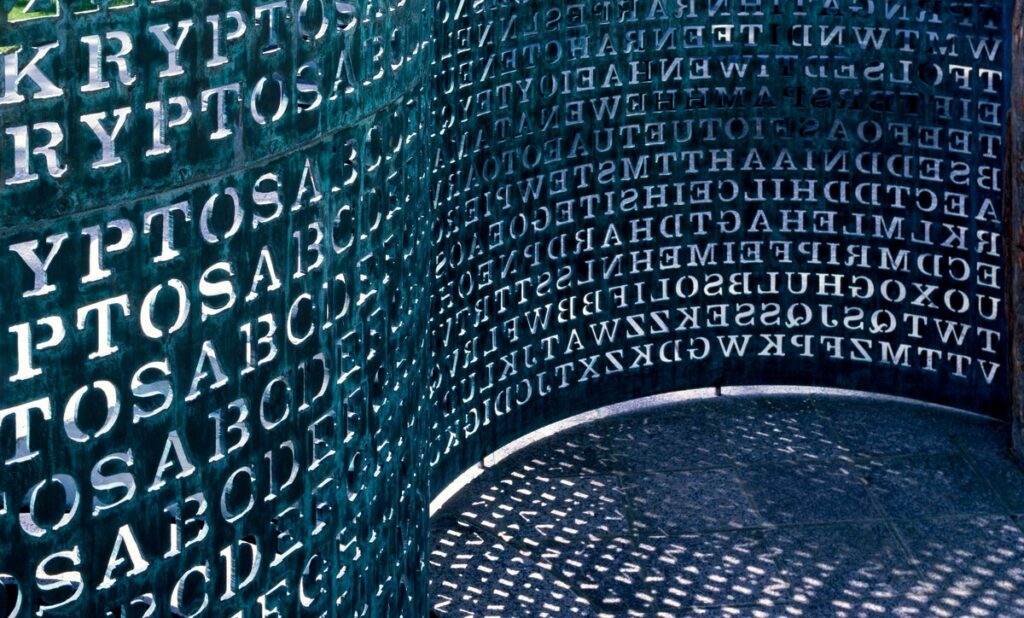October 16, 2025
3 min read
A Solution to the CIA’s Kryptos Code Is Found after 35 Years
After decades of speculation, two writers uncovered the answer to the Kryptos code’s final cipher
Kryptos, a work of art made of encrypted code, sits on the grounds of the C.I.A. Headquarters in Virginia
Buyenlarge/Contributor/Getty Images
After a 35-year quest, the final solution to a famous puzzle called Kryptos has been found. Two writers discovered the fourth answer to the code hidden among the Smithsonian Institution’s archives.
The puzzle, a copper sculpture engraved with four coded messages, has fascinated professional and amateur cryptographers since 1990, when artist Jim Sanborn installed it at the CIA’s headquarters in Virginia. The four encrypted messages are made up of 869 characters . The final section, K4, begins with “OBKR” and contains 97 letters. To claim a solution, one must show how they decoded it from that ciphertext.
The first three passages were solved during the 1990s, but the solution to the fourth, known as K4, had remained secret until now.
On supporting science journalism
If you’re enjoying this article, consider supporting our award-winning journalism by subscribing. By purchasing a subscription you are helping to ensure the future of impactful stories about the discoveries and ideas shaping our world today.
After years of failed attempts by enthusiasts to decode K4, Sanborn was preparing to auction off the solution, expected to fetch between $300,000 and $500,000. On September 3, however, he received an e-mail from journalists Jarett Kobek and Richard Byrne containing the full decoded text.
Kobek and Byrne found the solution after noticing in the auction listing that Sanborn’s “coding charts” were in the Smithsonian’s collection. Byrne photographed the papers, and Kobek later realized they included taped-together scraps that revealed K4’s original plaintext. The scraps contained the previously released clues “BERLIN CLOCK” and “EAST NORTHEAST,” part of the fully decoded message.
Sanborn confirmed the solution’s authenticity, explaining that he had mistakenly included those scraps in the archives while compiling documents during cancer treatment years earlier. Following the discovery, he asked the Smithsonian to seal the files for the next 50 years, and it complied.
In response to the news, RR Auction, the company handling the sale, warned Kobek and Byrne against publishing the text, threatening legal action for interference and copyright infringement. Both men told the New York Times they have no intention of releasing it.
A statement from RR Auction said that the materials offered in the planned sale provide the only authorized insight into how K4 functions as part of Sanborn’s artistic vision. It emphasized that while Kobek and Byrne may now know the plaintext, they do not possess the method by which K4 was encoded or the complete creative context of the work. “One thing is to have the words. It’s another to have the method,” says Elonka Dunin, a retired game developer and who co-moderates one of the world’s largest fan groups for Kryptos. “We’ve had many people over the years come up and say they solved it, but if they can’t show the method, they just get booted out of the room.”
The RR Auction statement noted that even if the text of K4 eventually becomes public, only the winning bidder will gain access to Sanborn’s full explanation of the relationship between K4 and a previously rumored fifth passage, as well as the intended meaning behind the complete Kryptos message. Reactions to the news from the cryptography community are divided. Some, including Dunin, feel relieved that someone might have finally deciphered the long-standing mystery of Kryptos. Others have described the way Kobek and Byrne found the answer as an “ugly end.”
However the saga ends, the fascination with Kryptos will likely endure. “For a piece of art, if you can get someone’s attention for 10 minutes, that’s pretty good,” Dunin says. “Sanborn now has a piece of art that has held people’s attention for 35 years.”
It’s Time to Stand Up for Science
If you enjoyed this article, I’d like to ask for your support. Scientific American has served as an advocate for science and industry for 180 years, and right now may be the most critical moment in that two-century history.
I’ve been a Scientific American subscriber since I was 12 years old, and it helped shape the way I look at the world. SciAm always educates and delights me, and inspires a sense of awe for our vast, beautiful universe. I hope it does that for you, too.
If you subscribe to Scientific American, you help ensure that our coverage is centered on meaningful research and discovery; that we have the resources to report on the decisions that threaten labs across the U.S.; and that we support both budding and working scientists at a time when the value of science itself too often goes unrecognized.
In return, you get essential news, captivating podcasts, brilliant infographics, can’t-miss newsletters, must-watch videos, challenging games, and the science world’s best writing and reporting. You can even gift someone a subscription.
There has never been a more important time for us to stand up and show why science matters. I hope you’ll support us in that mission.

